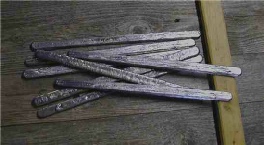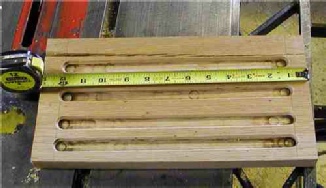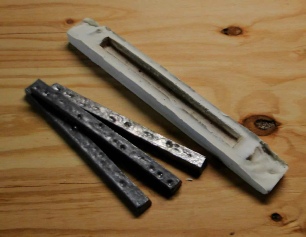Subject Guide

Mountain West
Malachite’s Big Hole
How to Make Small Lead Bars:
Small lead bars weighing approximately one-pound, were a common item taken to rendezvous
in the mountains. St. Louis prices for lead in the 1830's was about 7¢ a pound although
mountain prices were as much as $1.00 or more. At one-pound, these lead bars were
convenient to handle and to recast into balls.
7¢ a pound although
mountain prices were as much as $1.00 or more. At one-pound, these lead bars were
convenient to handle and to recast into balls.
These lead bars are modeled after those on display at the Museum of the Fur Trade in Chadron, Nebraska.
Making the Mold
To cast half-pound lead bars, first make the mold. I route channels into a wooden
board. I've used both plywood and hardwood. Molten lead does char the wood, and
hardwood will last longer than softwoods or plywood. I make the channels eleven
inches long. I start off by routing a flat bottom, 7/32" deep with a half inch diameter
flat bottomed bit. I then flare the sides using a 3/4" diameter round bit set to
a depth not quite 7/32" deep. As long as you've got your router set up, go ahead
and make multiple channels. It doesn't take much more time, and you'll be able to
cast a lot more bars before you need to make another mold. Lead bars with these dimensions
will weight approximately one and one-half pounds.
eleven
inches long. I start off by routing a flat bottom, 7/32" deep with a half inch diameter
flat bottomed bit. I then flare the sides using a 3/4" diameter round bit set to
a depth not quite 7/32" deep. As long as you've got your router set up, go ahead
and make multiple channels. It doesn't take much more time, and you'll be able to
cast a lot more bars before you need to make another mold. Lead bars with these dimensions
will weight approximately one and one-half pounds.
A two-pound lead bar with beveled sides can be cast using a plaster of paris mold.
To make the mold it is first necessary to make a wood form with the  desired shape
and dimensions. For a two-pound bar you will need a form 10.8 inches long by 0.6
inches thick and with an average width of 0.85 inches. After you’ve fabricated the
wood form, drive a screw near each end of the base of the form. These screws will
act as hand-holds for removing the wood form from the plaster after it’s set. Lastly,
polish the wood form with bar soap simplify removing from the plaster after its set.
Be sure to allow the plaster mold adequate time to cure and dry before using. Molten
lead will cause any moisture remaining in the mold to flash into steam resulting
in either spalling or cracking of the mold.
desired shape
and dimensions. For a two-pound bar you will need a form 10.8 inches long by 0.6
inches thick and with an average width of 0.85 inches. After you’ve fabricated the
wood form, drive a screw near each end of the base of the form. These screws will
act as hand-holds for removing the wood form from the plaster after it’s set. Lastly,
polish the wood form with bar soap simplify removing from the plaster after its set.
Be sure to allow the plaster mold adequate time to cure and dry before using. Molten
lead will cause any moisture remaining in the mold to flash into steam resulting
in either spalling or cracking of the mold.
Lead can easily be melted on an electric or gas stove. If you're married and stove-top metallurgy is not an option for you, a white gas camp stove in the basement or garage will also work. Molten lead does give off fumes and it is highly advisable to do your casting in a well ventilated area or out of doors. When handling molten lead you'll also want to be extremely cautious, as it will cause third degree burns in an instant. When pouring the molten lead, there is no hurry, the lead will not start solidifying for several minutes after its been removed from the heat. Fill the channel until the meniscus is slightly higher than the channel. At this time I spritz it with water; it helps solidify the lead faster, and minimizes charring of the wood mold. Also, note that if using a plaster mold, the plaster will exhale air after introduction of the molten lead resulting in “dimples” in the top surface of the lead bar after it solidifies. After the lead bars are solid (don't rush it to much or the bars will tear coming out of the mold) turn the mold upside down and rap the bottom with a plastic mallet. The bars will fall out of the mold. Don't be in too much of a hurry to pick up your new toys, they will remain scorching hot for several minutes.
You would like some bar lead for your outfit but can't make your own you can purchase some ready made here.
Back to the Top
Back to Skills and Plans